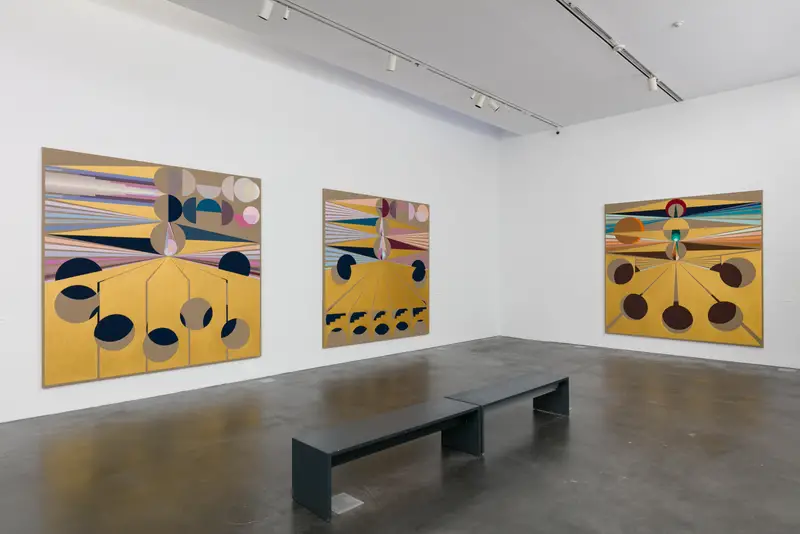Eamon Ore-Giron:
Installation view, Eamon Ore-Giron: Competing With Lightning/Rivalizando con el Relámpago, Museum of Contemporary Art, Denver, February 16, 2022–May 22, 2022. Photo by Wes Magyar.
Eamon Ore-Giron:
Miranda Lash, Ellen Bruss Senior Curator at the MCA Denver
Exploring the complex layering of identities, histories, and artistic legacies that have influenced Eamon Ore-Giron’s approach to painting, Eamon Ore-Giron: Competing with Lightning / Rivalizando con el relámpago at MCA Denver marks the first presentation to examine the artist’s trajectory over more than 20 years of creative practice.
On view February 16 to May 22, 2022, the exhibition follows the progression of Ore-Giron’s paintings since 2002 with an emphasis on recent works in abstraction that place this painting tradition within a broader and more complicated history of form in the Americas. Featuring more than two dozen works, most of which have not been seen publicly before now, Eamon Ore-Giron: Competing with Lightning / Rivalizando con el relámpago culminates with an immersive presentation of six new paintings from the artist’s Infinite Regress series created specifically for the exhibition.
These stunning large-scale paintings rendered with metallic gold on raw linen draw upon an international discourse of geometric abstraction that spans centuries, incorporating references that range from ancient Andean architecture to twentieth century modernism.
“Eamon Ore-Giron is a groundbreaking artist who challenges the rigidity of boundaries to catalyze new ways of seeing and understanding,” said Nora Burnett Abrams, Mark G. Falcone Director of MCA Denver. “It is an honor to be the first museum to showcase different chapters of this artist’s incredible practice, embodying Eamon’s creative risk-taking and MCA Denver’s commitment to pushing the cultural conversation in new directions.”
“The emergence of abstraction in the U.S. has largely been understood as deriving from twentieth-century modernism and related movements such as Abstract Expressionism,” said Miranda Lash, Ellen Bruss Senior Curator of MCA Denver. “Eamon challenges this narrative with references to modernist elements alongside pre-Columbian sources and contemporary indigenous culture that recontextualizes abstraction within a more expansive tradition of artistic creativity in the Americas.”
As an artist, musician, and DJ, Eamon Ore-Giron examines the personal and historical ramifications of cultural hybridity. Raised in Tucson, Arizona, he is inspired by his roots in the American Southwest, his visits to his father’s hometown of Huancayo, Peru, and his time spent as a practicing artist in California and Mexico.
Additionally, Ore-Giron is creating a new, site-specific mural in MCA Denver’s second-floor Vicki and Kent Logan Promenade Space. The exhibition will also include an artist-curated, tapestry lined, sound installation featuring music-based work by Ore-Giron, including seminal tracks he created as DJ Lengua, and hand-woven tapestries from his Talking Shit series.
Traveling Venues
Eamon Ore-Giron: Competing with Lightning / Rivalizando con el relámpago traveled to The Contemporary Austin, March 3, 2023 – August 20, 2023.
About the artist
Eamon Ore-Giron (b. 1973, Tucson, Arizona) blends a wide-range of visual styles and influences in his brightly colored abstract geometric paintings. Referencing indigenous and craft traditions as well as 20th Century avant-gardes, his paintings move between temporalities and resonate across cultural contexts. Ore-Giron also works in video and music, and his interdisciplinary projects explore the interrelationship of sound, color, rhythm, and pattern, and make manifest a history of transnational exchange. He has exhibited nationally and internationally, as a solo practitioner and as part of collaborative endeavors, and has been selected to realize major public commissions in New York and Los Angeles. Ore-Giron received a BFA from the San Francisco Art Institute and an MFA from the University of California, Los Angeles.

This exhibition is generously supported by The Fries Foundation and the Stapleton/Harmes C. Fishback Foundation. MCA Denver also thanks the Contemporary Circles Young-ish Circle Members and the citizens of the Scientific and Cultural Facilities District for their support of the exhibition.
